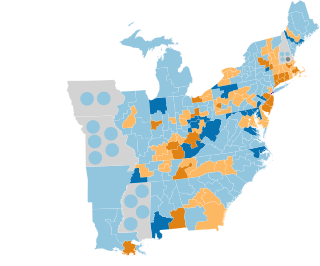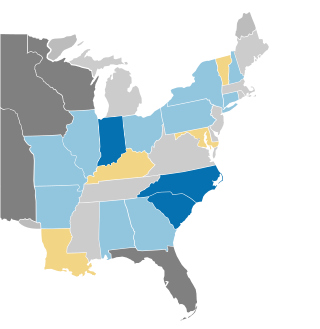
The 28th United States Congress was a meeting of the legislative branch of the United States federal government, consisting of the United States Senate and the United States House of Representatives. It met in Washington, D.C., from March 4, 1843, to March 4, 1845, during the third and fourth years of John Tyler's presidency. The apportionment of seats in this House of Representatives was based on the 1840 United States census. The Senate had a Whig majority, and the House had a Democratic majority.

The 1844–45 United States House of Representatives elections were held on various dates in various states between July 1, 1844 and November 4, 1845. Each state set its own date for its elections to the House of Representatives. 224 elected members representing 27 states took their seats when the first session of the 29th United States Congress convened on December 1, 1845. The new state of Florida elected its first representative during this election cycle, while one vacancy in New Hampshire's delegation remained unfilled for the duration of the 29th Congress.
The 1842–43 United States House of Representatives elections were held on various dates in various states between August 1, 1842 and November 8, 1843. Each state set its own date for its elections to the House of Representatives before the first session of the 28th United States Congress convened on December 4, 1843. The exception was Maryland, who held theirs so late that they ran into February 1844. These elections occurred during President John Tyler's term. The congressional reapportionment based on the 1840 United States census unusually decreased the number of House seats, from 242 down to 223.
The redistricting of United States congressional districts is made by the legislatures of the states every 10 years, immediately following the official announcement of the federal census that serves as the basis of the apportionment. It was long the practice that the apportionment thus made stood until after the next decennial census.

The 1843 United States Senate election in New York was held on February 7, 1843, by the New York State Legislature to elect a U.S. Senator to represent the State of New York in the United States Senate.

The 1848–49 United States Senate elections were held on various dates in various states. As these U.S. Senate elections were prior to the ratification of the Seventeenth Amendment in 1913, senators were chosen by state legislatures. Senators were elected over a wide range of time throughout 1848 and 1849, and a seat may have been filled months late or remained vacant due to legislative deadlock. In these elections, terms were up for the senators in Class 3.

The 1842–43 United States Senate elections were held on various dates in various states. As these U.S. Senate elections were prior to the ratification of the Seventeenth Amendment in 1913, senators were chosen by state legislatures. Senators were elected over a wide range of time throughout 1842 and 1843, and a seat may have been filled months late or remained vacant due to legislative deadlock. In these elections, terms were up for the senators in Class 3.

In the 1838 Iowa Territory Council elections, electors selected councilors to serve in the first Iowa Territory Council. All 13 members of the Territory Council were elected. Councilors served one-year terms.

In the 1839 Iowa Territory Council elections, electors selected councilors to serve in the second Iowa Territory Council. All 13 members of the Territory Council were elected. Councilors served one-year terms.

In the 1840 Iowa Territory Council elections, electors selected councilors to serve in the third Iowa Territory Council. All 13 members of the Territory Council were elected. Councilors served one-year terms.

In the 1841 Iowa Territory Council elections, electors selected councilors to serve in the fourth Iowa Territory Council. All 13 members of the Territory Council were elected. Councilors served one-year terms.

In the 1842 Iowa Territory Council elections, electors selected councilors to serve in the fifth Iowa Territory Council. All 13 members of the Territory Council were elected. Councilors served one-year terms.

In the 1844 Iowa Territory Council elections, electors selected councilors to serve in the seventh Iowa Territory Council. All 13 members of the Territory Council were elected. Councilors served one-year terms.

In the 1845 Iowa Territory Council elections, electors selected councilors to serve in the eighth and final Iowa Territory Council before Iowa attained statehood in 1846. All 13 members of the Territory Council were elected. Councilors served until the organization of the Iowa General Assembly in 1846 as the legislative branch of the new state of Iowa.

In the 1846 Iowa State Senate elections, Iowa voters elected state senators to serve in the first Iowa General Assembly. Elections were held for all 19 members of the State Senate. In the newly created Senate, members were to serve four-year terms. Members of the first General Assembly were classified into two groups. Nine of the newly elected senators would serve full four-year terms, while 10 drew short terms of two years and were up for re-election in 1848. This classification process began the rotation system whereby half the members of the Senate are elected biennially for full four-year terms.

In the 1848 Iowa State Senate elections, Iowa voters elected state senators to serve in the second Iowa General Assembly. Elections were held for 10 of the state senate's 19 seats. State senators serve four-year terms in the Iowa State Senate.

In the 1850 Iowa State Senate elections, Iowa voters elected state senators to serve in the third Iowa General Assembly. Elections were held for 11 of the state senate's 19 seats. State senators serve four-year terms in the Iowa State Senate.

In the 1852 Iowa State Senate elections, Iowa voters elected state senators to serve in the fourth Iowa General Assembly. Following the expansion of the Iowa Senate from 19 to 31 seats in 1852, elections were held for 22 of the state senate's 31 seats. State senators serve four-year terms in the Iowa State Senate.

In the 1854 Iowa State Senate elections, Iowa voters elected state senators to serve in the fifth Iowa General Assembly. Elections were held for 19 of the state senate's 31 seats. State senators serve four-year terms in the Iowa State Senate.

In the 1856 Iowa State Senate elections, Iowa voters elected state senators to serve in the sixth Iowa General Assembly. Following the expansion of the Iowa Senate from 31 to 36 seats in 1856, elections were held for 21 of the state senate's 36 seats. State senators serve four-year terms in the Iowa State Senate.










